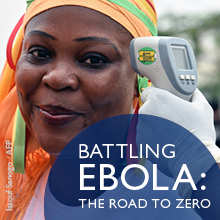USAID’s Higher Education Solutions Network (HESN) – a multidisciplinary research and development effort led by seven universities working to evaluate and strengthen real-world innovations in development – recently spotlighted young academics and their creative approaches to development challenges during TechCon 2013, the first annual HESN meeting in Williamsburg, Virginia. As part of a contest, more than 40 students and researchers presented innovations designed to help communities in developing countries.
Winner Brian Gitta, from Makarere University in Uganda, invented a tool that can diagnose malaria without the need for blood samples and a laboratory. This is the story of that innovation.
Brian Gitta wasn’t in the mood to get stuck by another needle – he was already getting injections three times a day to fight off a foodborne illness. But as his fever spiked and the pain in his joints worsened, he suspected he was suffering yet another occurrence of malaria, the disease he’d contracted as a child and currently kills one child every minute in the developing world.
A nurse at a local clinic confirmed his suspicion by drawing blood using a needle and syringe. “I hated the needles and kept thinking of ways people could be diagnosed without pain,” Gitta recalled.

Brian Gitta, from Makerere University in Uganda pitches his winning idea that uses cell phones and light – not needles and blood samples to test for malaria. Photo Credit: Cynthia Kao-Johnson/USAID
That puzzle was still on Gitta’s mind weeks later as he began his studies in Computer Science at Makerere University and started thinking about ways technology could be used to improve malaria detection. The standard method of determining whether someone has malaria is drawing blood and viewing it under a microscope, which requires health workers and facilities that are scarce in many low-income communities. For Brian, the goal wasn’t just to alleviate momentary pain; eliminating needles and the need for a lab would not only limit the risk of infection but allow for diagnosis in communities that had no medical centers.
Gitta shared the idea with his friend Joshua Businge and they began researching new ways to detect malaria. They learned that for years, light sensors have been used to read the blood’s oxygen content through the skin. This seemed like a promising avenue to explore, so the pair recruited Josiah Kavuma and Simon Lubambo, students skilled in engineering hardware. Together, the team designed a prototype that plugs into a smartphone and can detect malaria using only light. Results are available in seconds and the smartphone can email them and map them for epidemiological purposes. They named the device Matibabu, Swahili for medical center.
By coincidence, Makerere University was launching an initiative called the ResilientAfrica Network (RAN) as part of HESN and an upcoming launch event in Uganda would give local innovators an opportunity to demonstrate concepts for solving public problems. The team demonstrated their prototype to Alex Dehgan, director of USAID’s Office of Science and Technology, RAN director William Bazeyo, and Deborah Elzie from RAN partner Tulane University. “I was very impressed,” Elzie said. “When we talk about innovation, people are often just improving on something that’s already out there…These guys really found a whole new way of looking at how to determine if someone has malaria.”
RAN searches for creative minds like Gitta’s and helps them overcome obstacles that often keep bright ideas from making it to the marketplace. RAN gave Gitta’s team a workspace, training on writing business proposals, mentoring, and the resources needed to make a better prototype.
They teams hopes to a commercially viable product and plans to partner with an established organization working against malaria.
Reflecting on his innovation, Gitta noted, “as long as you put your mind and hard work to it, you can accomplish anything at any age.”


Leave a Reply